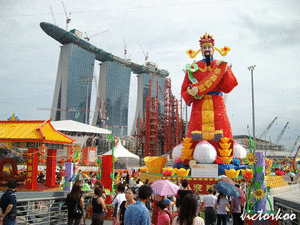With the opening of the Resort World Sentosa last week, the topic for this article is still about gambling.
MM Lee is right, the Chinese are congenital gamblers. I was introduced to

I think why she wanted me to do it for her was because our block did not have a lift and we stayed on the 4th storey. In her opinion, a young boy like me would definitely take less effort to climb up and down the stairs compared to a middle-aged woman suffering from rheumatoid arthritis. Being a filial son, I always complied with her orders. Well, she might not be aware then that by doing so, she could be doing more damage to my future than she would have done to her knees.
She would pass me a betting slip that didn't resemble this at all:
 Image taken from Singapore Pools website
Image taken from Singapore Pools websiteInstead, it looked something like this:
 The wager on the left is on my favorite numbers "6-9" and is called a "pai pai" (排排,Cantonese for "next to each other" or "horizontal") bet . The one on the right is a "jek lok" (直落,"straight down" or "vertical") bet on the numbers 7-10 (How the game is played and the payout system are explained in this Singapedia entry and I need not explain them here.)
The wager on the left is on my favorite numbers "6-9" and is called a "pai pai" (排排,Cantonese for "next to each other" or "horizontal") bet . The one on the right is a "jek lok" (直落,"straight down" or "vertical") bet on the numbers 7-10 (How the game is played and the payout system are explained in this Singapedia entry and I need not explain them here.)My mum, like many housewives of those days, was not formally educated. So instead of indicating the amount of the bet, she would draw symbols - a circle with one slash across it meant 50 cents, a circle with an X across it meant 1 dollar and a smaller circle stood for 10 cents. Technically speaking, the smallest acceptable bet was 10 cents but I think the smallest bet my mum ever placed was 30 cents. Her highest bet on a number was no more than a few dollars so there was no need for symbols of bigger currency denominations. (For the record, the amount for the left bet is $1.80 while the right one is $2.40. Easy, isn't it?)
In return for placing the bets, the coffeeshop owner 阿东(Ah Dong) would scribble a receipt for me in a small notepad and give me a carbon copy.
My mum was meticulous in keeping track of the past winning chap ji ki numbers. She had sheets of A4 sized cards on which she recorded them. She would take them out for study before placing any bets. However, whether this method worked for her or not, I don't know. Although she did strike once in a while, I think like in all gambling, she suffered a net loss overall.
Luckily, in those days, the coffeeshop didn't bar those aged under 18 from buying chap ji ki. If it did, I certainly wouldn't have lived to tell this story. But even more fortunately in my opinion, is that I didn't grow up to be a compulsive gambler, whether through nature or nurture. And for that, I thank the God of Fortune.



















